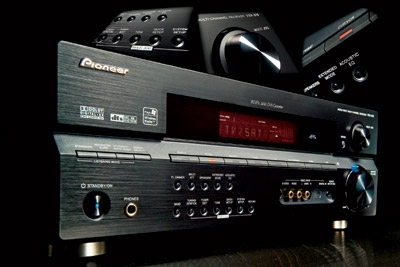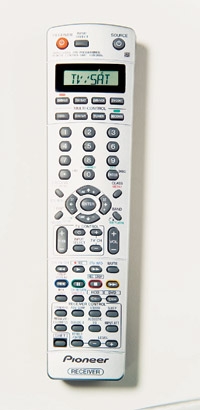Cost Control Page 4

| VSX-815 RATED POWER 100 W x 7 into 8 ohms with maximum 1% THD DIMENSIONS 16 5/8 x 6 1/4 x 15 7/8 inches WEIGHT 221/4 pounds PRICE $365 MANUFACTURER Pioneer USA, pioneerelectronics.com, 800-421-1404 PLUS • Auto-setup matches receiver to speakers • Good selection of surround modes for movies and music • Excellent remote control with LCD MINUS • Auto-EQ system might not improve sound |
While this may have little import in the near term, the VSX-815 is also one of the few devices of any kind that can decode signals in the Windows Media Audio 9 format (including its "lossless" mode) on the fly - for instance, if you stream a WMA9 song from a computer or portable player into one of the receiver's digital audio inputs. To encourage that application, it has an optical connector on the front panel, a rare feature even on flagship receivers.
 Pioneer's multicomponent, preprogrammed remote control neither glows in the dark nor lights up, but it has two things that compensate. An LCD readout tells you which of the programmed components you're operating, and its silver color makes it easy to find individual buttons even in a fairly dark room (though it's hard to read their labeling).
Pioneer's multicomponent, preprogrammed remote control neither glows in the dark nor lights up, but it has two things that compensate. An LCD readout tells you which of the programmed components you're operating, and its silver color makes it easy to find individual buttons even in a fairly dark room (though it's hard to read their labeling).
SETUP Like the other two receivers in this group, the Pioneer has no onscreen display and counters this with an easy-setup mode where you choose among presets for speaker complement and room size. Here again, the presets will not likely match your setup close enough to give optimal results. But the Pioneer has another card up its sleeve. It offers fully automatic setup - a feature that used to be found only in flagship models, though entry-level receivers need it most.
You simply connect the supplied microphone to the corresponding front-panel input, place it at your listening position, press a few buttons, and wait for the VSX-815 to do its magic. The receiver sends test tones to each speaker in turn, and these are picked up by the mike and used to make the necessary adjustments for speaker "size" (based on its bass capability, not on whether it's physically large or small), distance compensation, and balance levels. As a "bonus," the automatic setup system can also equalize (EQ) your main speakers (all but the subwoofer, which receives only a level adjustment) to achieve a nice, flat frequency response in your room.
MOVIE AND MUSIC PERFORMANCE The settings for speaker size, distance, and level balance were essentially what I would have gotten with a careful manual setup, but the auto EQ made the tonal balance of our system too bright. Like other auto-EQ systems I've played with, Pioneer's can do more harm than good with many high-quality speaker systems, but unlike most others, Pioneer's lets you either turn it off or manually tweak the results and store them in two custom memories. Of course, being able to easily turn the EQ on and off makes it a cinch to decide whether you like its effect.
Happily, the Pioneer's audio performance matched its user-friendliness and feature set. The receiver was extremely quiet, and it could play every bit as loud as the Marantz, both in listening tests and in the lab. This allowed all the surround modes to perform their magic without strain or obtrusive noise. You'll be looking for the debris after the Phoenix crash!
Priced between the Sony and the Marantz, Pioneer's VSX-815 is a bargain. It's easy to use, and with its auto-setup feature, you can be confident you're getting the best possible performance out of your speakers.
- Log in or register to post comments





















































